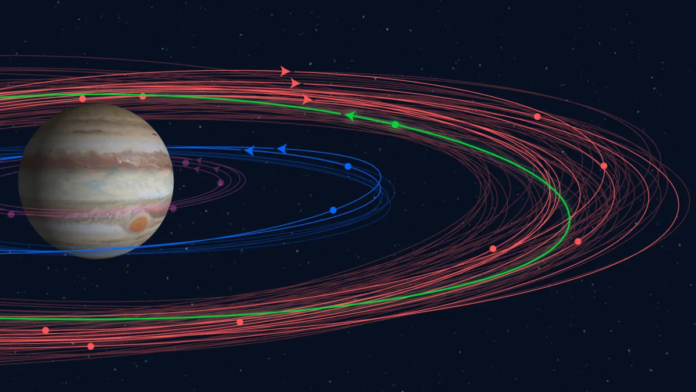Jupiter isn’t just the largest and most massive planet in the solar system — now, the gas giant also boasts the largest number of moons orbiting it after scientists discovered another 12 moons, bringing the behemoth’s total up to 92.
The orbits of the 12 hitherto undiscovered moons of Jupiter have been published by the Minor Planet Center (MPC) operated by the Smithsonian Astrophysical Observatory, according to a new report from Sky and Telescope. The dozen new moons represent a 15% increase in the planet’s known moons. With these new discoveries, Jupiter seizes the record for “solar system planet with most moons” from the previous record holder, Saturn.
Scientists have found 83 moons to date around the ringed gas giant, the second-largest planet in the solar system. However, astronomers have also found tons of rocks down to about 2 miles (3 kilometers) wide around Saturn without yet tracking the objects precisely, according to Sky and Telescope (opens in new tab). As instruments become capable of studying these smaller moons, Jupiter may have to relinquish its new title back to Saturn.
Related: Juno photos reveal more stunning glimpses of Jupiter’s ice-covered moon Europa
Scott Sheppard, an astronomer at the Carnegie Institute for Science in Washington, D.C., has submitted the observations of the Jovian system, which were taken between 2021 and 2022, for publication. The delay between observing the new moons and confirming them comes because astronomers had to track the rocks for a full orbit in order to ensure they were actually orbiting Jupiter.
And all of the new moons circle Jupiter far from its surface, taking more than 340 Earth days to complete an orbit of the gas giant, according to Sky and Telescope. Of the 12 new moons, nine are particularly distant: The MPC estimates these nine moons to have orbits longer than 550 days. These moons are all also relatively small: only five of those nine moons are thought to have a diameter greater than 5 miles (8 km).
The nine particularly distant moons also have retrograde orbits, meaning that they circle the gas giant in the opposite direction of its rotation; the inner Jovian moons, in contrast, have “prograde” orbits in the same direction as the planet’s rotation. The new moons’ retrograde orbits imply that Jupiter’s immense gravitational influence may have captured these moons, with the smaller ones possibly the remains of larger bodies broken apart by collisions.
Others of the newly found moons are in prograde orbits, suggesting they formed around Jupiter. These particular prograde orbiting moons are located in a middle swath of space with 13 other Jovian moons: closer to the planet than the outer retrograde moons but farther away than the large inner moons — Io, Europa, Ganymede and Callisto — which are referred to as the Galilean moons because they were first discovered by Galileo Galilei in the early 1600s.
These prograde moons were tougher to spot than the outer retrograde Jovian moons. “The reason is that they are closer to Jupiter and the scattered light from the planet is tremendous,” Sheppard told Sky and Telescope. The light reflected by Jupiter obscures these moons, so by 2000 astronomers had discovered only five of these moons. In the intervening two decades, only eight more of this group had been found.
Prograde Jovian moons outside of the Galilean moons fall into two groupings. The closest is the Himalia group, which is named after the fifth largest Jovian moon, Himalia. The group lies between 6.8 million to 7.5 million miles (11 million to 12 million km) from Jupiter and has a population of nine, two of which are among the new discoveries.
Thus far only one Jovian moon has been discovered between the Galilean moons and the Himalia group, Themisto, possibly due to the glare from the gas giant hiding smaller moons.
Further out at around 10 million miles (17 million km) from Jupiter are the Carpo group, named after Carpo, a Jovian moon Sheppard discovered in 2005. Before this clutch of discoveries, there was only one moon in this group besides Carpo itself, so the discovery of another doubled the population of this group.
The newly discovered prograde Jovian moons could make excellent targets for future missions that are set to make flybys of Jupiter, including the European Space Agency’s JUICE mission set to launch in April and NASA’s Europa Clipper set to launch in October 2024.
Follow us on Twitter @Spacedotcom or on Facebook.

